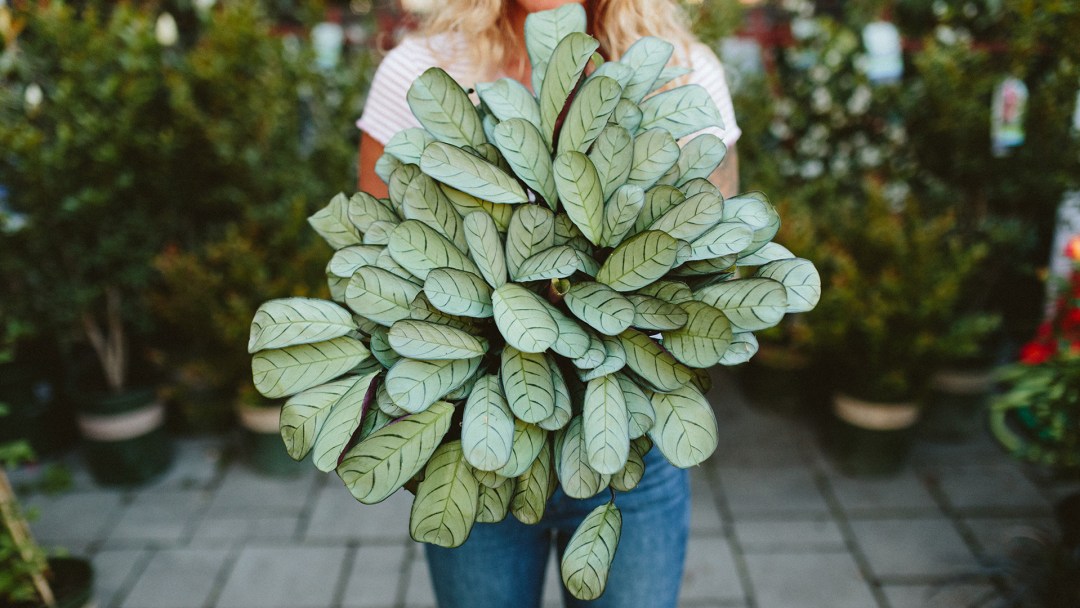Like any houseplant trend, variegated plants have plant lovers and connoisseurs going crazy. However, unlike other trends in the past, the love of variegated plants does not seem to be diminishing with time.
So, what makes variegated plants so special? Understanding the science behind variegation is key to knowing why some of them are considered so rare and sought after. When you think of variegated plants, you may think of random sprinkles and dots of white along a plant’s leaves. However, there are 4 different types of variegation, each one with very distinct characteristics.
Pattern-Gene Variegation
This form of variegation is the most common type since it occurs naturally. Appearing as a specific pattern on each leaf, pattern-gene variegation is not a mutation, but part of the plant’s DNA. Some of the most popular houseplants have this form of variegation such as prayer plants, calathea, and Chinese evergreens. Many pattern-gene variegated plants today are cultivars—a result of select plants being cultivated to create new hybrid patterns.

Chimeral Variegation
Chimeral variegation is one of the most sought-after types of plant variegation. It is named after the Chimera in Greek Mythology that possesses the head of a lion, the body of a goat, and the tail of a serpent. This variegation is caused by a genetic mutation, creating a plant that has two different chromosomal makeups within it; one that can produce chlorophyll and one that cannot. This causes white or yellow shapes and splotches to mix with the green on the leaves and even stems. The Variegated Monstera Deliciosa is the result of chimeral variegation.
Chimeral variegation can appear in a random pattern with large white or yellow areas as well as speckles of the color surrounding them, but it can also cause leaves to emerge completely white or completely green. Other times, it can remain consistent throughout the plant in more of a pattern like half-moon leaves. Although all white leaves on a monstera are gorgeous, the white or yellow color lacking chlorophyll hinders photosynthesis, often causing the leaf to die a short time after unfurling.
Depending on the plant and the variegation, some forms may be unstable, meaning they may revert to solid green and lose their variegation. For this reason, only some plants that have chimeral variegation can be propagated from stem cuttings, and there is not always a guarantee that the variegation will persist in the new plant. These are two reasons why variegated plants can be more difficult to come by, and scarcity increases demand.


Blister or Reflective Variegation
This type of variegation is caused when an air pocket is formed on a leaf—the lower tissue contains chlorophyll, while the upper tissue does not. This creates a white or silver reflective color on that part of the leaf. These air pockets can form in more random splotches, like on a Scindapsus pictus, or they can form along the veins of the leaves, creating a striking pattern like that of many anthuriums.


Viral Variegation
A much less common form of variegation is one that stems from a virus in a plant. Not many indoor plants have this variegation, but one example is caused by the mosaic virus. Although most of the time you won’t want to see variegation from a virus on your indoor plants, tulips are a good example of an outdoor plant that has been cultivated to remain variegated from a virus.

Caring for Variegated Plants
Because variegated leaves lack chlorophyll, indirect, bright light is best for most of these types of plants. Low light conditions can cause a variegated plant to lose its pattern and turn mostly green. If this happens, provide brighter light and the plant should return to its former self after a few months. All white or heavily variegated leaves can also be prone to sunburn, so be sure to keep them out of prolonged direct sunlight as well.
Occasionally, a variegated plant will begin to “revert” to all green leaves as the plant grows. These green leaves may grow faster than the rest of the plant and overtake the variegated portion over time if not pruned away. Ficus benjamina ‘variegata’ has this tendency and should have the green branch removed near the trunk if this occurs.
6 Variegated Plants We Love
Monstera Albo (chimeral variegation)

White Princess Philodendron (chimeral variegation)

Calathea Vitata (pattern-gene variegation)

Variegated String of Hearts (pattern-gene variegation)

Anthurium Regale (reflective variegation)

Scindapsus Pictus (reflective variegation)

Unlike other houseplant trends in the past, we think this one is going to stick around! The good news is, no matter what your budget is or how long you have been caring for houseplants, there is a variegated plant out there for you!

